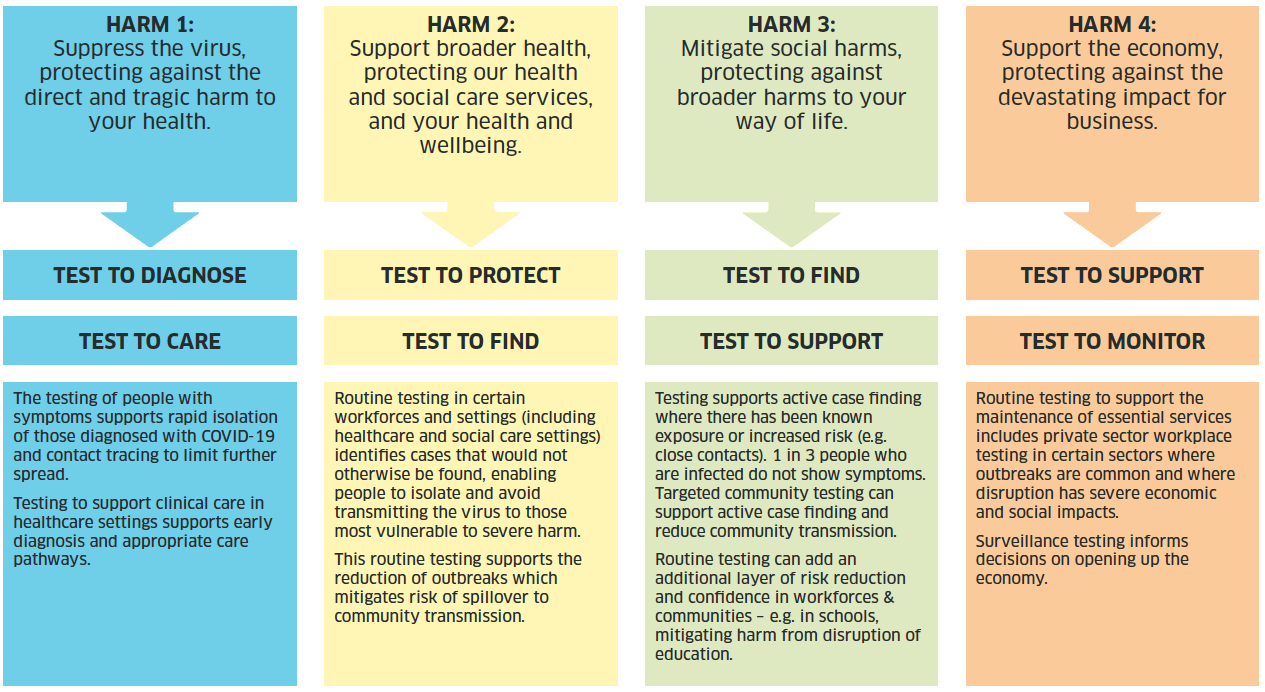Coronavirus (COVID-19) - testing strategy: update - March 2021
An updated testing strategy for Scotland, following the recent publication of Coronavirus (COVID-19) Scotland’s Strategic Framework updated, published on 23 February 2021.
2. Why we test: six purposes
Testing Strategic Intent
Given the current state of the epidemic in Scotland, our overall strategic intent in the updated Strategic Framework, and the technology and capacity now available, our overall strategic purpose for testing is to:
make optimal use of Scotland's testing capacity to suppress the virus to the lowest possible level and keep it there, while supporting the return to as normal a life as possible, mitigating the four harms caused by the crisis, and building a legacy of improved resilience and preparedness for current and future health threats.
Within this overall strategic purpose, there are six rationales for testing at an individual, community and population level, set out below.
Rationales for Testing
The original Testing Strategy set out five reasons for our priorities for testing for COVID-19 in Scotland: testing to diagnose anyone with symptoms of COVID-19; testing for clinical care of patients; testing to protect those vulnerable to the most harm from COVID-19; testing to proactively case find among people without symptoms, and testing for surveillance to monitor prevalence and understand disease transmission.
The clinical and scientific review published in October set out the consensus view of our senior advisers that testing anyone with symptoms and testing for clinical care are the overarching priorities for the Testing Programme. Testing for these purposes – and testing for ongoing surveillance – will likely remain core elements of Scotland's continuing COVID-19 testing infrastructure on a permanent basis as COVID-19 moves from a pandemic phase to endemic.
In addition, the most recent expansion of routine testing announced on 2 February extends testing for a sixth purpose: to support the maintenance of essential services and mitigate wider social and economic harms. Testing to support our strategic intent to support the resumption of life as close to normal as possible is likely to grow in significance as we move through the phases outlined in the updated Strategic Framework.
These six rationales for testing can therefore be summarised as:
1. Test to Diagnose all those with symptoms of COVID-19 to enable rapid isolation of confirmed positive cases and contact tracing of their close contacts who may be potentially infectious, to advise them to isolate, thereby stopping onward spread of the virus infecting other people.
2. Test to Care for those receiving clinical care in hospital and those admitted to hospital on a planned or emergency basis to both support optimal patient care and the selection of appropriate care pathways, and to reduce the risk of hospital-based outbreaks. All people moving to care homes from hospital or the community are also tested prior to admission.
3. Test to Protect those most vulnerable to severe harm through routine testing, for example, staff in healthcare and social care settings including hospitals, primary care workplaces, and adult care homes, so that those who test positive can isolate and avoid risking transmitting to those most vulnerable.
4. Test to Find and interrupt chains of transmission through Targeted Community Testing and testing all close contacts of positive cases.
5. Test to Support the resilience of essential services and mitigate the wider social and economic harms caused by the pandemic. This includes routine testing to support the safe return to school, in higher and further education environments, and extending an offer of routine testing to businesses in food production and distribution.
6. Test to Monitor the prevalence of the disease at a population level, detect early signals of new incidence, detect new variants of concern, and understand transmission dynamics (including the impact of vaccination on transmission) in key sectors.
Figure 1 below illustrates these six purposes of testing and their relative contribution to mitigating the four harms caused by the virus. The six purposes of testing are not mutually exclusive, and where there are instances where testing a particular group on a regular basis contributes to multiple purposes, then the overall case for prioritisation of that particular testing may be strengthened.

Contact
Email: ceu@gov.scot
There is a problem
Thanks for your feedback